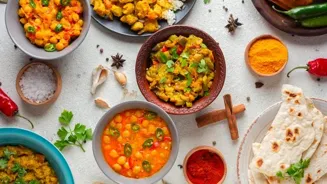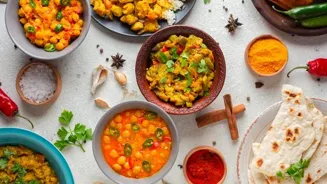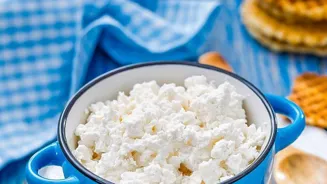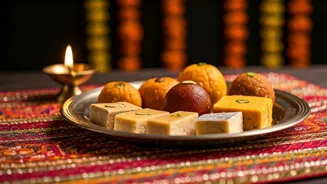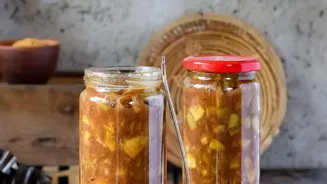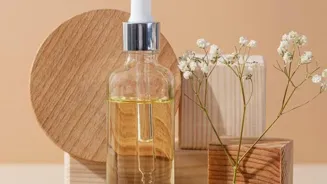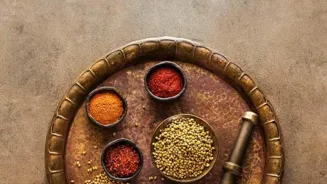Unveiling the Science of Baking Perfect Indian Sweets at Home! Dive into the art & science behind your favorite mithai
Diwali just went by, and the festive season is still in the air! Everyone's craving
delicious Indian sweets, right? But buying them all the time can become expensive and honestly, the quality isn't always the best. Ever thought about making them yourself?
Baking Indian sweets at home might seem daunting, especially when you recall your sweets turning into hard rocks. But with a little understanding of the science behind baking, you can become a master baker of your favourite mithai.
It's all about understanding the ingredients and their roles, mastering a few techniques, and adding a pinch of patience! Remember, even the most experienced halwais started somewhere. And the joy of serving homemade sweets, made with love, is simply unmatched.
So, ditch the store-bought stuff and let's unlock the secrets to perfect Indian sweets at home!
Indian dessert ingredients: ghee, sugar, flour. Balance is key
First, let’s talk about the key ingredients that act as the backbone of most Indian desserts: ghee, sugar, and flour or semolina. Ghee, or clarified butter, isn't just a flavour enhancer, it also plays a crucial role in texture. It adds richness and helps to bind the ingredients together.
Sugar offers sweetness and helps with browning. And whether you're using all-purpose flour (maida), whole wheat flour (atta), or semolina (suji), each one contributes a unique quality. Maida will give you a softer finish, atta a nutty flavour and courser feel, and suji adds a grainy texture.
The ratio of these ingredients is key! Too much ghee and your sweets become greasy, too little and they’re dry. Too much sugar and they’re cloyingly sweet, too less and... well, what’s the point? Experiment with ratios, starting with tested recipes, and adjust to your palate.
Remember, even slightly tweaking the traditional ratio of 'besan' to ghee in 'besan ladoos' will impact the overall texture of the sweet. Understand each aspect of these ingredients and improve your mithai creation skills.
Baking powder and soda: key to light and dense Indian sweets
The magic of baking powder and baking soda! These are those little leavening agents that can make your sweets light and airy, or dense and chewy, depending on how you use them. Baking soda (sodium bicarbonate) needs an acidic ingredient like yogurt or lemon juice to activate.
This creates carbon dioxide gas which makes batter rise. Baking powder, on the other hand, is a complete package – it contains both the base and an acid, so it only needs liquid to activate.
But here's a tricky part about using it in Indian sweets, many of which rely on dense textures, like 'pedas' or 'barfi'. In these sweets, you wouldn't usually use a leavening agent. But for sweets like 'nangkhatai', even just a pinch makes a big difference in puffiness and flakiness.
Using too much leavening agent can cause your sweets to collapse or have an unpleasant taste, so always follow the recipe exactly.
Keep in mind that leavening agents slowly lose their potency even before their expiry dates, so it’s always adviseable to store them in airtight containers and consume them within a few months of opening.
Mastering Indian sweets: Gulab Jamun & Jalebi science
Now, let's get into some specific Indian sweets and the science behind perfecting them. First, the all-time favorite, Gulab Jamun! The secret for soft, melt-in-your-mouth gulab jamuns lies in the khoya (reduced milk solids).
Kneading the khoya well is absolutely crucial as it develops the gluten in it making it elastic hence preventing the jamuns from breaking while frying. Also, a touch of baking soda helps to give that spongy texture. Frying them on a low flame is very important.
This ensures they cook evenly from the inside out and turn a beautiful golden brown. For perfectly caramelized sugar syrup, balancing the water to sugar ratio is vital. A string consistency is what you're after - too thin and it won't coat the jamuns properly; too thick and they will crystallize.
Then there's jalebi. Getting that crispy, crunchy texture requires precise batter consistency and temperature control while frying. The batter needs to be fermented properly, usually overnight. This helps create air pockets that give it the signature crispness.
Stirring and timing are crucial in making barfi and ladoos
Next, think about barfi. Whether it's milk barfi, besan barfi, or kaju barfi, the key is in constant stirring as you cook the ingredients. This prevents the mixture from sticking to the bottom of the pan and ensures every bit of the mixture is evenly cooked. The cooking time also matters a lot.
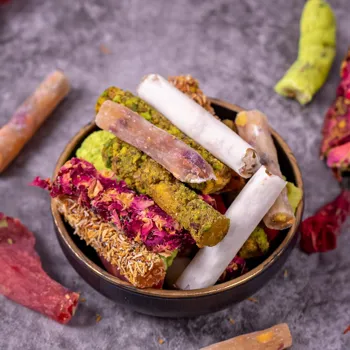
Overcook it and your barfi will be hard and crumbly. Undercook it and it won't set properly. Knowing when to stop cooking is an art! For ladoos, the magic ingredients are ghee and the flour you're using.
Roasting the flour properly in ghee until it turns a beautiful golden brown and gives off a nutty aroma gives them a fantastic flavour. The consistency of the ghee matters too. Make sure it’s melted but not too hot when you mix it with the roasted flour.
Too hot and it will scald the flour, too cold and the laddoos won’t bind properly. The technique behind making the perfect 'motichoor ladoo' involves using a specific 'boondi' ladle and frying the batter in hot ghee or oil to produce tiny, pearl-shaped boondis.
Experiment with baking traditional sweets to create new flavors and techniques, enjoy the process
Lastly, don't be afraid to experiment! Once you've mastered the basics, feel free to try new flavours and techniques. Add a little cardamom to your barfi, saffron to your gulab jamuns, or nuts to your laddoos. Try different types of flour or play with the sugar levels.
Baking is a science but it's also an art. The most important thing is to have fun and enjoy the process. And even if things don’t turn out perfectly the first time, don’t get discouraged. Every batch is a learning experience.
Now go give your old mithai a new twist, or recreate a brand new delicious mithai, and get ready to impress your family and friends with your newfound baking skills. The best thing is, homemade sweets always taste better.
Knowing that you put your heart and soul into making them just makes them even more special. So happy baking, and happy eating!
AI Generated Content. Glance/InMobi shall have no liability for the content